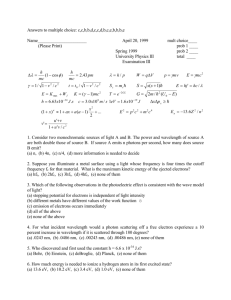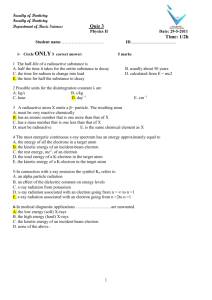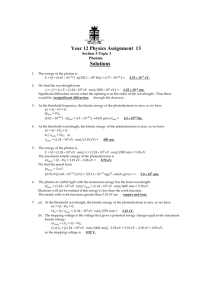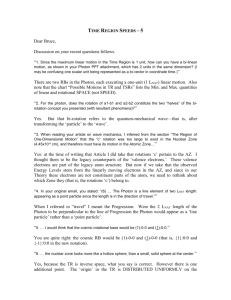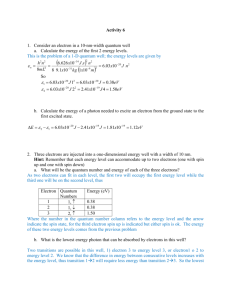CH28-Quantum Physics..
advertisement
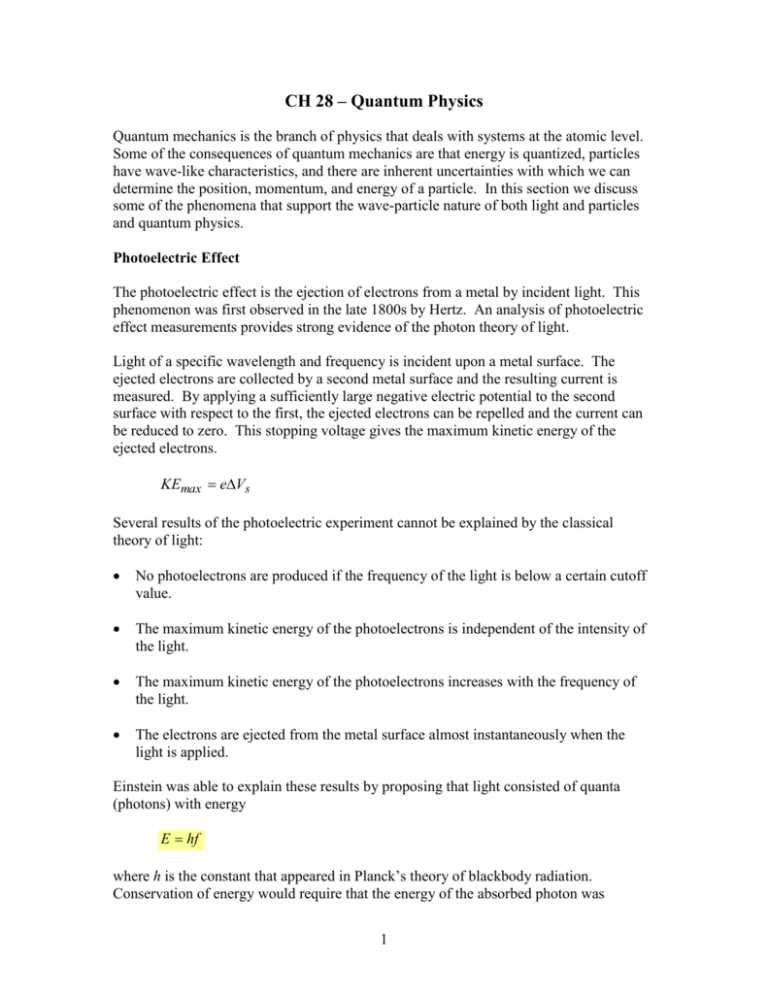
CH 28 – Quantum Physics Quantum mechanics is the branch of physics that deals with systems at the atomic level. Some of the consequences of quantum mechanics are that energy is quantized, particles have wave-like characteristics, and there are inherent uncertainties with which we can determine the position, momentum, and energy of a particle. In this section we discuss some of the phenomena that support the wave-particle nature of both light and particles and quantum physics. Photoelectric Effect The photoelectric effect is the ejection of electrons from a metal by incident light. This phenomenon was first observed in the late 1800s by Hertz. An analysis of photoelectric effect measurements provides strong evidence of the photon theory of light. Light of a specific wavelength and frequency is incident upon a metal surface. The ejected electrons are collected by a second metal surface and the resulting current is measured. By applying a sufficiently large negative electric potential to the second surface with respect to the first, the ejected electrons can be repelled and the current can be reduced to zero. This stopping voltage gives the maximum kinetic energy of the ejected electrons. KEmax eVs Several results of the photoelectric experiment cannot be explained by the classical theory of light: No photoelectrons are produced if the frequency of the light is below a certain cutoff value. The maximum kinetic energy of the photoelectrons is independent of the intensity of the light. The maximum kinetic energy of the photoelectrons increases with the frequency of the light. The electrons are ejected from the metal surface almost instantaneously when the light is applied. Einstein was able to explain these results by proposing that light consisted of quanta (photons) with energy E hf where h is the constant that appeared in Planck’s theory of blackbody radiation. Conservation of energy would require that the energy of the absorbed photon was 1 converted into work to extract the electron from the metal with the excess energy going into the kinetic energy of the ejected electron. That is, hf KE work . The minimum work needed to extract an electron is called the work function, , for which the kinetic energy of the electron is a maximum. Thus, we have hf KEmax , or KEmax hf Example: The work function for Zn is 4.31 ev. What maximum wavelength of light would be required to produce photoelectrons from Zn? Solution: KEmax 0 hf hc / hc / ( 6.6 x10 34 Js )( 3 x108 m / s ) /( 4.31evx1.6 x10 19 J / ev ) 2.88 x10 7 m 288 nm ( UV ) If the wavelength of the light were 200 nm, what would be the maximum kinetic energy of the ejected electrons? Solution: KEmax hf hc / ( 6.6 x10 34 Js )( 3x108 m / s ) / 2 x10 7 m ( 4.31evx1.6 x10 19 J / ev ) 3.00 x10 19 J 1.78 ev X-ray Production If very high energy electrons strike a metal, then x-rays are produced. The figure below shows an x-ray tube in which the electrons are accelerated though a potential difference and strike a tungsten target. 2 As the electrons are deflected by nuclei inside the target they loose kinetic energy by radiating photons. The maximum photon energy would correspond to the electron being completely stopped with all the energy being converted to that of a photon. eV hf max hc min , or min hc eV So x-rays would be produced with a range of wavelengths ranging from min to infinity. In addition to this continuous range of wavelengths (called bremsstrahlung radiation) there can be some discrete wavelengths where the intensity is strong. These characteristic wavelengths are a result of quantum transitions within the atoms. The impinging electrons may have enough kinetic energy to kick out an electron from an inner orbit of an atom. An x-ray photon would then be produced when an electron from an outer orbit drops down to fill this vacancy. Example: What accelerating voltage would be needed to produce x-rays whose shortest wavelength is 1 nm? 3 Solution: V hc emin ( 6.6 x10 34 Js )( 3 x108 m / s ) ( 1.6 x10 19 C )( 1x10 9 m ) 1,238V X-ray Diffraction One of the important applications of x-rays is in analyzing the structure of materials. In crystal diffraction, monochromatic x-rays are diffracted from a crystal lattice. The diffracted intensity is a maximum at angles that depend on the wavelength, the types of atoms in the crystal, and their atomic spacing. The figure below shows x-ray beams reflected from adjacent atomic planes. In order for the reflected beams to be in phase, the additional distance traveled by the lower beam must be an integral number of wavelengths. This so-called Bragg condition is 2d sin m , where m = 1, 2, 3, … and d is the distance between the atomic planes. Note that this formula is similar, but not the same, as the formula for diffraction maximum from a diffraction grating. In the formula above, is measured from the atomic planes, not the perpendicular to the planes. Also, note the factor of 2. Compton Effect In the Compton Effect, high energy photons are scattered from the electrons in a solid and the wavelength of the scattered photons is measured as a function of the scattering angle. This effect, discovered by Arthur Compton, provides further evidence of the quantum nature of light. 4 This process can be analyzed using conservation of energy and momentum. Assuming the energy and momentum expressions for the photon and the relativistic expressions for the energy and momentum of the electron, the difference in the wavelengths of the scattered and incident photons can be calculated to give ' h ( 1 cos ) , mc where is the scattering angle of the photon. Example: If the wavelength of the incident photon is = 0.05 nm, what is the wavelength of the scattered photon at 45o? Solution: ( 6.6 x10 34 Js ) 31 8 ( 1 cos 45o ) 7.1x10 13 m ( 9.11x10 kg )( 3x10 m / s ) ' 0.05nm 0.0007nm 0.0507nm How much kinetic energy is imparted to the electron? Solution: KE hc hc 1 1 1 1 hc( ) ( 6.6 x10 34 )( 3x108 )( ) ' ' 0.05 x10 9 0.0507 x10 9 5.47 x10 17 J 342 ev 5 Wave-Particle Duality of Matter We have previously seen how light can exhibit both wave-like and particle-like properties. The wave-like properties are demonstrated in interference and diffraction effects. The particle-like properties are demonstrated in phenomena in which the concept of the photon is important, such as the photoelectric effect and the Compton effect. For the photon, the energy and momentum relationships are E hf and p h De Broglie suggested that particles with a non-zero rest mass such as electrons and protons should also have both particle-like and wave-like properties and postulated that the above relationships for the photon should also hold for particles with mass. Example: What is the wavelength of an electron whose kinetic energy if 10 keV? Solution: Since KE << mc2, we can use the classical expressions to find the momentum. KE 1 mv 2 2 p2 2m p 2m( KE ) 2( 9.1x10 31 kg )( 1x10 4 ev )( 1.6 x10 19 J / ev ) 5.40 x10 23 kg m / s h 6.63 x10 34 J s 1.23 x10 11 m 0.0123 nm 23 p 5.40 x10 kg m / s This wavelength is of a sufficient size to use electrons to image materials on an atomic and molecular level, as in transmission electron microscopes. Example: What is the wavelength of a baseball traveling at 30 m/s? Solution: Mass of baseball = 0.145 kg 6 h h 6.63x10 34 J s 1.52 x10 34 m p mv ( 0.145kg )( 30m / s ) This wavelength is so small that it is impossible to detect the wavelike nature of a baseball. Wave Functions Schroedinger postulated that the wave-like nature of particles with mass could be described by a ‘wave function’, , that is a function of position and time. He postulated a mathematical equation, now called the ‘Schroedinger equation’, which can be used to solve for the wave function. The physical meaning of is that 2 is a measure of the probability of finding the particle at a certain position at a certain time. is somewhat like the electromagnetic field wave associated with the photon. The intensity of the electromagnetic wave is proportional to E2 or B2. Uncertainty Principle One of the consequences of the wave concept of particles is that there is an uncertainty in precisely locating the position of the particle. wave function probability function In general, the wave function and the probability function have a finite extent in space, as shown above. So, rather than having an exact location of the position of the particle, we could only say that it has a probability of being within a certain region of space. The fact that the wave function is localized rather than being a sinusoidal wave extending infinitely through space means that the wavelength, and thus the momentum, of the particle are also not precisely defined. The more we try to localize the wave function and the position of the particle, the more uncertain is the wavelength and momentum of the particle. This so-called Heisenberg uncertainty relationship is given by p x x h 2 7 where px and x are the uncertainties with which one can determine the momentum and position of the particle. (Note: Some textbooks give the uncertainty principle with h/4 on the right of the above equation. It depends on how the uncertainty is defined.) Another way of looking at the uncertainty relationship is as follows. If we wanted to try to precisely determine the position of a particle, we would have to shine light on it. Since light is a wave, the best we could do is determine the position to within approximately one wavelength of the light due to diffraction effects. So, we would have x . In addition, at least one photon with momentum p = h/ would collide with the particle and transfer at least this much momentum to the particle, which would increase its momentum uncertainty. If we try to decrease the uncertainty in determining x by decreasing the wavelength of the light, then we increase the uncertainty in the momentum by increasing the momentum transfer from the photon. There also exists a similar uncertainty relationship between energy and time, given by Et h 2 This says that it is impossible to precisely determine energy of a particle in a finite time t. The shorter the time of the measurement, the larger is the uncertainty in the energy and vice versa. Example: An electron is observed to have a speed of 5 x 105 m/s to within an accuracy of 1%. What does this say about the uncertainty with which we can locate the electron? Solution: p mv (9.11x10 31 kg)(5 x103 m / s) 4.56 x10 27 kg m / s x h 6.63x10 34 J s 2.32 x10 8 m 23.2 nm 2 p 4 (4.56 x10 27 kg m / s) Example: The half life of the charged pi meson is 2.6 x 10-8 s and its rest mass energy is 139.6 Mev. What is the uncertainty in its rest mass energy? 8 Solution: E h (6.63x10 34 J s ) 4.06 x10 27 J / 1.6 x10 19 J / ev 2.6 x10 8 ev 8 2 t 2 (2.6 x10 s ) Thus, the short lifetime has virtually no effect on how precisely one can determine the rest mass energy. Particle in a box The wave nature of a particle can lead to quantization of energy if the particle is confined within a finite region of space. A simple example is a particle confined to move freely in one dimension along a line of length L. Since the particle can't exist beyond the ends of the line, then the wave function must be zero at the ends. Thus, Ln 2 , or 2L n where n = 1, 2, .... Then the energy (kinetic) is 2 p 2 (h / ) 2 2 h En n 2m 2m 8mL2 9


